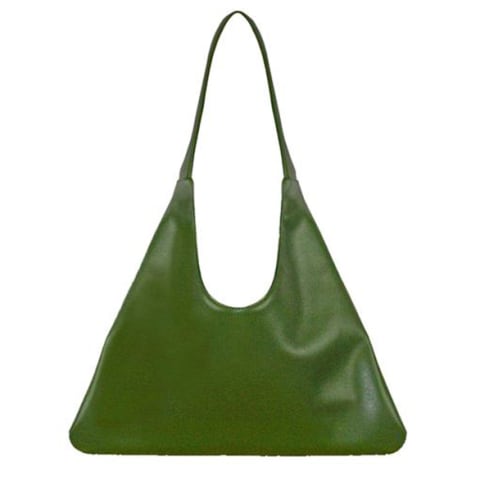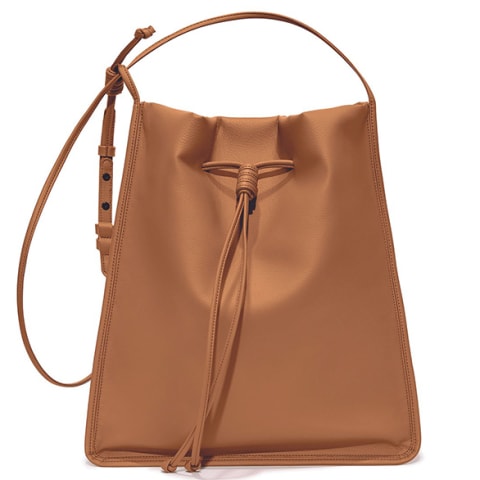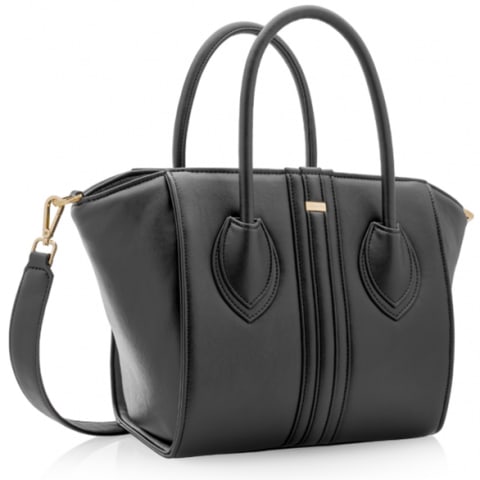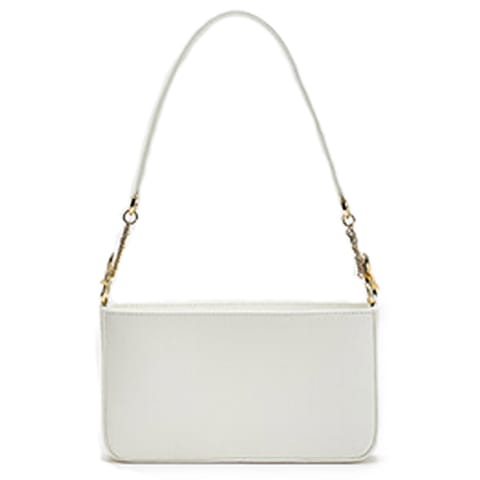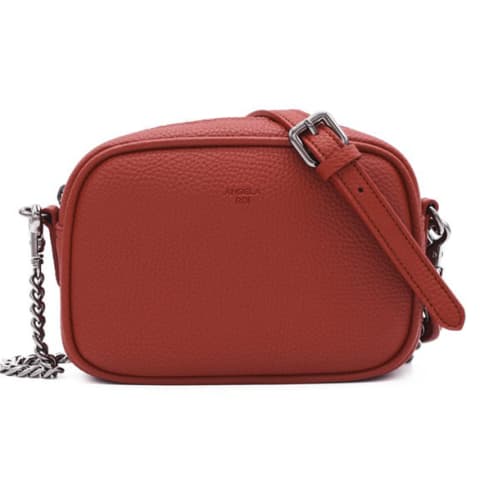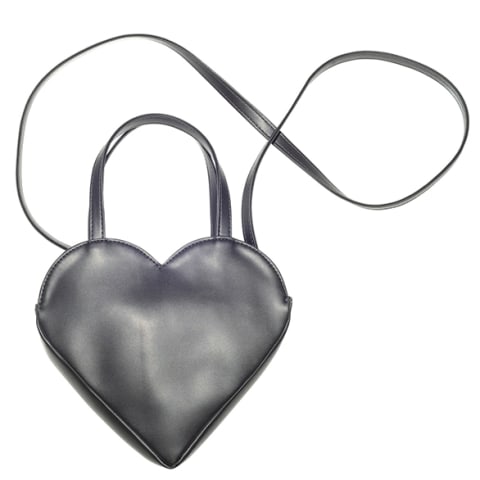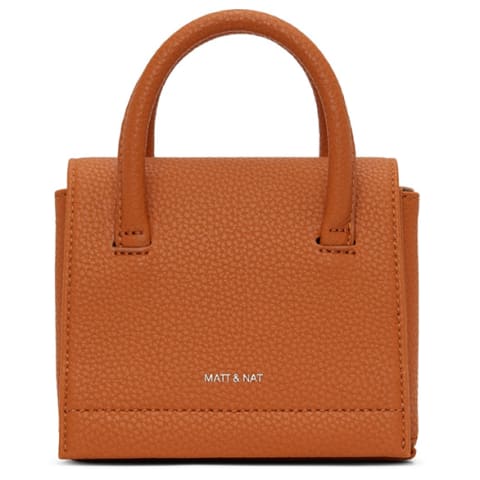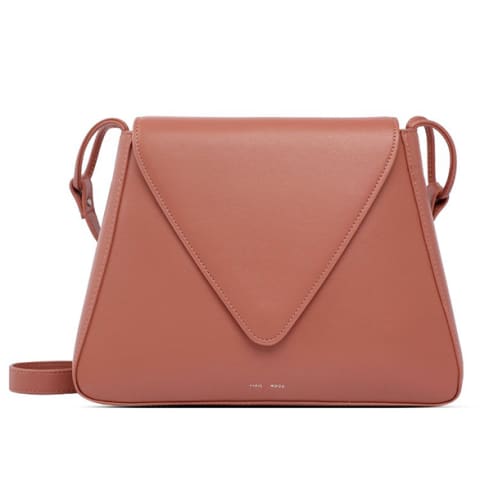If you’re hoping that yours tells the world you have a classic style—but also care about animal livelihood—vegan leather purses are probably on your radar. Shopping for a vegan purse that will spare animals without destroying the environment? We’ve got those in the bag. Here are the pros and cons of this material, plus some of our favorite brands. And while conventional leather often needs to be treated with dangerous chemicals like formaldehyde1, vegan leather doesn’t require the preservative. Instead, vegan leather mimics some of the positive qualities of leather—durability, breathability, flexibility, wrinkle-resistance—using materials other than animal skin. So, what are those? What does the “P” in the infamous pleather stand for? More often than not, vegan leather is made from polyvinyl chloride (PVC) or polyurethane (PU). “In other words,” Preeti Gopinath, a textile designer and associate professor at Parsons’ School of Fashion tells mbg, “it’s plastic.” And as we all now know, plastics derived from fossil fuels come with a number of environmental concerns. They are energy-intensive to produce, difficult to responsibly dispose of, and tend to linger in the environment for a long, long time. From this standpoint, vegan leather is not the most sustainable material. Part of what makes it so difficult to create a truly sustainable vegan leather—one that is petroleum-free and biodegradable—is that it takes chemicals to achieve many of the impressive qualities of leather. As Gopinath points out, biodegradable fabrics are meant to degrade in sun, wind, and water, yet we want our leather alternatives to stand up to all of these elements when we use them. “We are asking the material to do too many things,” she says. “We are asking it to be biodegradable and resist water and sun. If it has to resist all of that, obviously it won’t be biodegradable.” At the end of the day, sustainable stylist Cassandra Dittmer agrees that comparing vegan leather to animal leather is a bit like comparing apples to oranges. They’re different, and one isn’t inherently better than the other from an environmental perspective. Which one you choose will require you to weigh the pros and cons, and then decide which qualities you value most. “I will be the first person to say: Use nylon, use polyester, use these synthetics—but only if you’re not going to throw them away,” Gopinath says. You’ll also want to be careful how you care for your keepsake, as plastic microparticles can be shed in the wash and pollute waterways. Thankfully, this isn’t as much of a concern with synthetic purses as it is with, say, bathing suits. To guide your shopping, Dittmer points out that some vegan leathers made from PVC and PU incorporate recycled materials, like plastic water bottles. Better yet, there are also a number of up-and-coming vegan leather materials that are made from plants and not plastics. “Piñatex is a common one from pineapple leaf fiber that has made its way to a bunch of big brands,” Dittmer says, and leather made from mycelium hides and algae coating are also in development. Gopinath is excited to see some of her own students working on these bio-based, plastic-free leathers, though she notes that it will take time and money for them to become as affordable, accessible, and readily available as animal leather. In the meantime, they tend to be tougher to find and cost a pretty penny. They are made using the best and brightest in renewable, plant-based materials, or recycled plastic materials where that isn’t possible. If you’re not quite ready to shell out, we also included some more affordable polyurethane (PU) options that are responsibly made and easy to love for life. Each brand also has some sustainability perks of its own, like low-waste packaging or a philanthropic commitment. Price: $250 The outside of this funky purse is handcrafted from cactus fiber “leather,” while the inside is lined with a blend of cotton and recycled plastic bottles. For each handbag sold, Santos also plants a tree with One Tree Planted. Santos Agave Triangular Tote in Green Price: $295 This casual messenger bag may look like real leather, but it’s actually made using quick-growing bamboo fiber that’s been processed into yarn. Its interior is made from recycled plastic. von Holzhausen The Sac Price: $346.14 This bag is worth the splurge for its transparency and commitment to innovative plant-based materials: The sleek black Model 1.4 is “grape leather,” made from 75% wine leftovers and grape oil, 25% polyurethane. Held together with nontoxic glue and handmade hardware, it’s a stunner down to the details. Alexandra K Model 1.4 Price: $367.50 Both a clutch and a crossbody thanks to a removable chain, this versatile bag is made from 50% cactus fiber, 50% cork. Handmade in Greece, it would make a stunning impression worldwide. Mashu Philippa White Price: $195 This textured polyurethane bag from cult-favorite vegan brand Angela Roi is decked out with a cellphone compartment and an adjustable chain strap, making it a functional pick for daily use. The company also seeks to be transparent about its labor practices and claims to pay its hand-crafters fair wages to work in clean, comfortable factory conditions. Angela Roi Grace Micro Crossbody Price: $160 Dittmer commends small L.A.-based company HOZEN for its give-back program. If you’ve outgrown any of their bags, you can send them in to be recycled (and snag a discount on your next one). Made from biopolyoil—polyurethane mixed with a byproduct of the grain industry—its heart-shaped bag is a vegan dream. HOZEN Black Heart Bag Price: $77 This sharp satchel is made from polyurethane, and the interior lining is created from recycled plastic bottles. As part of the brand’s “Purity” collection, its outer coating is made from recycled windshield glass resin. We love that it comes with a detachable, adjustable crossbody strap to fit multiple occasions. MATT & NAT Adel Micro Vegan Satchel Price: $37 This pretty poly crossbody features linings made entirely from recycled plastic bottles and is on major sale right now. Pixie Mood Tiffany Crossbody Emma received her B.A. in Environmental Science & Policy with a specialty in environmental communications from Duke University. In addition to penning over 1,000 mbg articles on topics from the water crisis in California to the rise of urban beekeeping, her work has appeared on Grist, Bloomberg News, Bustle, and Forbes. She’s spoken about the intersection of self-care and sustainability on podcasts and live events alongside environmental thought leaders like Marci Zaroff, Gay Browne, and Summer Rayne Oakes.


